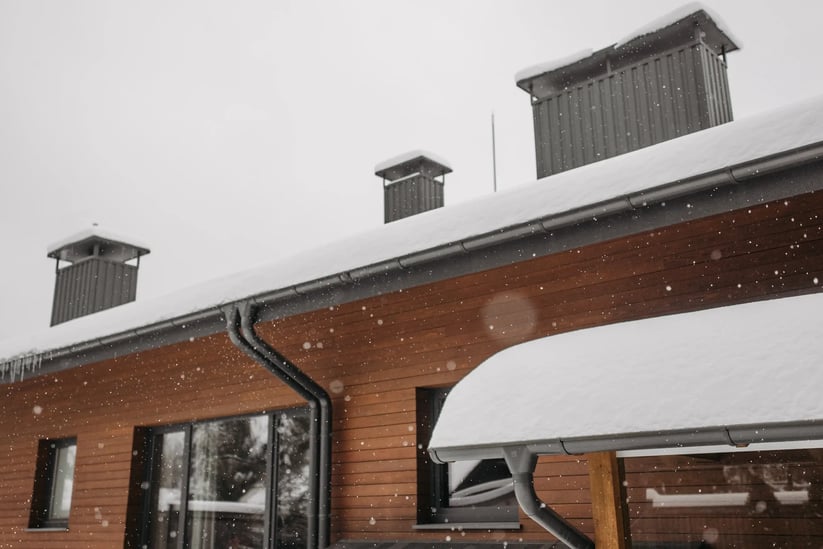
In the Midwest, winter is a long and cold season. Homeowners need to know how to prepare their homes for winter and have a routine maintenance checklist to keep them in the best shape possible through the snow and ice. The roof, especially, needs to be up to the task of keeping the interior warm and dry.
Have your roof inspected frequently for leaks, damage, and proper ventilation. Properly ventilating your home’s attic space will help protect your roof, your home, and your indoor air quality throughout the winter season. Keep in mind that while installing ventilation or replacing your roof in the winter is possible, it’s generally easier to do so before winter saets in.
Why does roof ventilation matter?
Proper ventilation can stop heat and moisture buildup before it can cause long-lasting damage. It can also help keep your heating and cooling costs low and extend the lifespan of your roofing system.
As heat and moisture accumulate in your home from cooking, showering, and heating your living spaces, it rises to the attic, where, without proper ventilation, it remains trapped just below the roof. This trapped heat then causes moisture in the air to condense into droplets. This moisture can dampen insulation, reducing its insulating power, as well as contribute to wood rot and mold and mildew growth, which can lead to structural damage.
A properly ventilated roof should have exhaust vents high up on the peak or ridge as well as intake vents low underneath the overhang. These vents allow for continuous air flow throughout the attic, drawing cooler air from outdoors through the overhang vents, which rises as it gets warmer to exit through the roof vents.
How do I know if my roof has improper ventilation?
Ice Buildup or Warped Shingles
If it is the middle of winter, check to see if ice is building up along the edge of your roof outside. You can also look out for roof and shingle warping: a wavy or rippled appearance to the roofline is a major sign of trapped moisture. Keep your safety in mind while inspecting the outside of your roof, especially in the winter. Rather than going to the top, simply walk around your home and look up from the ground.
Icicles Hanging from the Roofline
Got icicles? In Iowa, where the temperature drops below freezing many times throughout the winter, warm air that remains trapped in the attic due to improper ventilation can cause accumulated snow to melt on the roof. This snowmelt can then trickle down to the edge of the roof, where it refreezes and forms icicles. This is called an ice dam, and it can eventually cause water to back up under your shingles, which can lead to major water damage and an expensive repair bill.
Unusually High Heating and Cooling Bills
If you notice your heating and cooling bills have increased without an obvious reason, improper attic ventilation could be to blame. If the attic insulation has become wet from condensation, it will be less effective, and your HVAC system will have to work harder. Similarly, a frequent need for HVAC repair could also be a sign of an inefficient ventilation system, as a unit that has to work much harder than it should will tend to break down more.
Increased Illness
A potential sign of ventilation problems to watch out for is illness. If you and your family have seen an increase in allergy symptoms or respiratory sickness, this could be due to low air quality in your home. If ventilation in the attic is insufficient, then mold and mildew may grow, seriously diminishing the quality of indoor air.
How can you fix poor ventilation?
If you’re concerned that your roof isn’t properly ventilated, begin by contacting trusted local roofing professionals. They can help you understand the types of ventilation available and recommend solutions that are best suited for your home. Some common solutions include ridge vents, gable vents, and soffit vents.
Ridge vents provide an even temperature distribution to your roof and are installed along the entire ridge. Because they do not depend on the wind flow, they can perform well in any season. Gable vents, on the other hand, are typically installed on the side of the home, where they can act as both intake and exhaust vents.
Soffit vents are among the most popular type of intake vent. Often made from aluminum, soffit vents come in a wide variety of styles to match the look of your home and are easily installed underneath the roof overhang. These vents may be the best option for a homeowner in Iowa, as they can withstand the changing seasons and protect your home year around.
Subscribe to our blog today for more tips on keeping your roof and the rest of your home protected in every season.








Comments